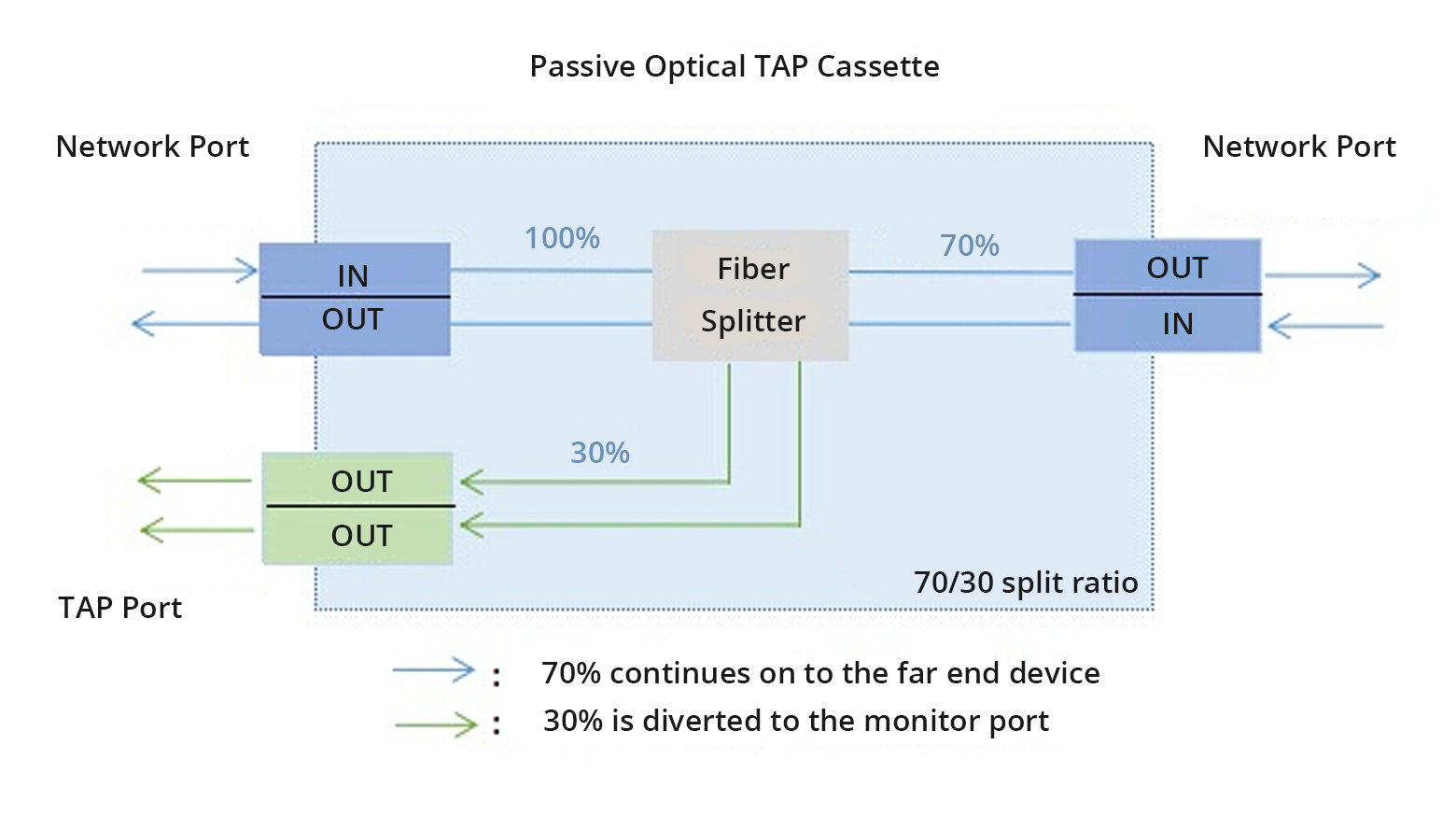Split Ratio
What is Split Ratio of TAP Cassettes?
The split ratio of TAP Cassettes in fiber optic networks refers to how optical power is distributed among the output ports of an optical splitter. It is written as a combination of two percentages. The first number is designated as the network percentage. The second number is the monitor percentage. They always add up to 100 percent. Generally, the TAP split ratio is available at 50/50 or 70/30. A 50/50 split ratio would indicate that 50% of the light budget coming into the optical TAP from the network is passed along to the end device, and 50% of the light budget is diverted to the monitoring device. Whereas in a 70/30 split ratio, 70% of the light budget is passed along to the end device and only 30% of the light budget is passed along to the network monitoring device.

The Importance of Split Ratio
The split ratio in a fiber optic network TAP is an important factor to consider for proper network monitoring and performance. Here are a few reasons why the split ratio is significant:
-
1. Signal Integrity: The split ratio determines how much of the optical signal is diverted to the monitoring device and how much is passed along to the end device. It is crucial to maintain signal integrity and ensure that the monitoring device receives sufficient light for accurate analysis while not compromising the performance of the network link.
-
2. Loss Budget Calculation: The split ratio is used in the calculation of the loss (power) budget. The loss budget helps determine the allowable signal loss throughout the network infrastructure. By considering the split ratio, the appropriate budget can be calculated to ensure that the network and monitoring devices receive adequate signal strength.
-
3. Monitoring Effectiveness: The split ratio directly affects the visibility and effectiveness of network monitoring. If the split ratio is too high, with a significant portion of the light budget diverted to the end device, the monitoring device may receive insufficient light for comprehensive analysis. On the other hand, if the split ratio is too low, the end device may experience signal degradation due to excessive light diversion to the monitoring device.
-
4. Flexibility and Scalability: The ability to adjust the split ratio allows for flexibility and scalability in network monitoring. Different monitoring scenarios or network requirements may call for varying split ratios to optimize monitoring capabilities without impacting network performance.
Application of Different TAP Split Ratios
Different TAP split ratios are applied based on varying monitoring requirements and network environments. Here are some common applications of different TAP split ratios:
-
1. 50/50 Split Ratio: This is the most common split ratio, where 50% of the light budget is passed to the end device, and the remaining 50% is directed to the monitoring device. This split ratio is suitable for scenarios that require a balance between network performance and comprehensive monitoring. It provides an equal distribution of signals, ensuring that the monitoring device receives sufficient light for accurate analysis.
-
2. 70/30 Split Ratio: This split ratio allocates 70% of the light budget to the end device and only 30% to the network monitoring device. It is applicable in situations where there is a higher demand for network performance while still requiring a certain level of monitoring. It reduces the light received by the monitoring device to some extent, maintaining higher network performance.
-
3. 90/10 Split Ratio: With this split ratio, 90% of the light budget is directed to the end device, while only 10% is passed to the monitoring device. This split ratio is suitable for scenarios that prioritize maximum network performance, with relatively lower monitoring requirements. It utilizes almost all the light for the end device, ensuring maximum network performance.
-
4. Custom Split Ratios: In some cases, custom split ratios can be employed based on specific monitoring needs. This can be determined based on the specific requirements of the network and the flexibility of the monitoring devices. By adjusting the split ratio, network performance and monitoring effectiveness can be optimized according to the specific circumstances.
You might be interested in
Email Address

-
PoE vs PoE+ vs PoE++ Switch: How to Choose?
Mar 16, 2023








